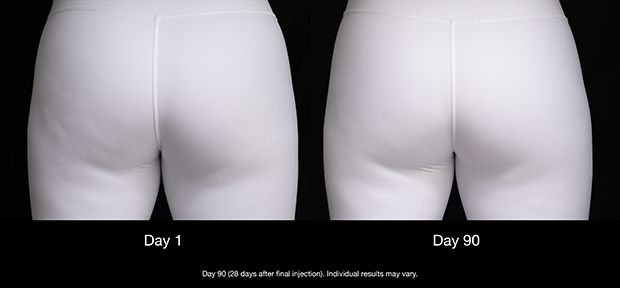That’s because cellulite has nothing to do with diet or lack of exercise, according to Dr. Bruce Katz, the Director of the New York Juva Skin & Laser Center. Katz, a dermatologist, who is also a Clinical Professor at The Icahn School of Medicine at Mt. Sinai, has been treating patients with QWO and participated in the FDA studies of the treatment, before its approval.
“Exercise can improve the appearance of cellulite a little, but I’ve seen it on marathon runners and triathletes,” says Katz, who explains that cellulite is caused by fibrous bands that connect the skin to underlying muscles. When the bands start to thicken- usually after puberty, sometimes worsening after pregnancy – the bands pull down the skin and create the signature dimples known as cellulite.”

The procedure involves three treatments, separated by three weeks each. An injection is made into every dimple on the patients’ thighs and/or buttocks. Pictured here is day 1, the first day of treatment, (left), & to the right are the results from 71 days later (right). (Courtesy of QWO)
So why is cellulite something that afflicts women and not men? “The fibrous bands are vertical in women and when they thicken, they pull down,” points out Katz. “For men, the fibrous bands attach to the underlying muscle at angles, they are more diagonal. That’s why women develop fat pockets on the hips and thighs and men develop more in the stomach and therefore get ‘love handles’.”
Just like Kathleen and Janine, Dr. Katz has treated patients with other cellulite treatments including a laser treatment called cellulase, but none achieved the improvements of QWO.

The enzymes in QWO – called collagenases – are injected into each cellulite dimple. These enzymes “attack the two types of collagen that are in the hardened fibrous bands under the skin and dissolves them,” explains Dr. Katz. Pictured here are before & after photos of treatment from day 1 (left) & day 90 (right). (Courtesy of QWO)
Here’s how QWO works to erase cellulite: the enzymes in QWO – called collagenases – are injected into each cellulite dimple. These enzymes “attack the two types of collagen that are in the hardened fibrous bands under the skin and dissolves them,” explains Dr. Katz.
The procedure involves three treatments, separated by three weeks each. An injection is made into every dimple on the patients’ thighs and/or buttocks.
Dr. Katz says that depending on the patient, he will need one or two vials of QWO. Each vial contains enough QWO to inject into 12 dimples and the needles are tiny.
Both Janine and Kathleen report that the needles are “uncomfortable” but not “painful.” “It feels like you’re getting little needles in your legs and buttocks,” describes Janine.
There is little downtime. Dr. Katz says patients only need to avoid exercise the day of treatment though Janine waited four to five days after her first treatment before hitting the gym again.
Both women said that soreness and some bruising were less of an issue after the second and third treatments.
But it was after just the second treatment that both women were astounded by the improvement in the look of their cellulite. “I was super, super satisfied,” Kathleen said after her second treatment. “After the second round, I was so improved that I felt like I didn’t even need to do the third,” Janine remembers.
Despite both women noticing the vast improvement in the appearance of their cellulite after two procedures, both were told by Dr. Katz, who treated them, that it was essential to complete the treatment.




